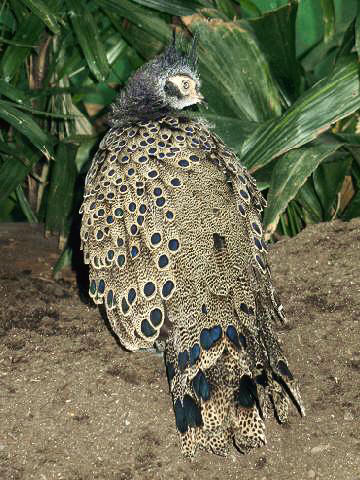|
| 질의: Small white | 결과: 1090번째/2237 | |
Malayan Peacock-pheasant (Polyplectron malacense) - Wiki
| 제목: | Malayan Peacock-pheasant (Polyplectron malacense) - Wiki
| |

| 해상도: 360x480
파일크기: 57482 Bytes
등록시간: 2007:09:28 17:17:36
|
Malayan Peacock-pheasant
From Wikipedia, the free encyclopedia
[Photo] Malayan Peacock-pheasant (Polyplectron malacense) taken at Bronx Zoo, New York. Photo by http://en.wikipedia.org/wiki/User:Stavenn | Permission is granted to copy, distribute and/or modify this document under the terms of the GNU Free Documentation License, Version 1.2 or any later version published by the Free Software Foundation; with no Invariant Sections, no Front-Cover Texts, and no Back-Cover Texts. A copy of the license is included in the section entitled "GNU Free Documentation License". |
The Malayan Peacock-pheasant, Polyplectron malacense also known as Crested Peacock-pheasant or Malaysian Peacock-pheasant is a medium-sized, up to 53cm long, spotted black, brownish pheasant with an elongated dark blue green crest, bare red facial skin, bluish-white iris and green ocelli on upperbody plumage and its tail of twenty two feathers. The female is smaller and duller than male.
A shy and elusive bird, the Malayan Peacock-pheasant is distributed and endemic to lowland forests of Malay Peninsula. At one time, this species was widespread in Malaysia, Thailand and also reported from Myanmar, Singapore and Sumatra. It is now disappeared from most of its former range. The remaining population confined to central Malaysia.
Together with the even more elusive Bornean Peacock-pheasant - its sister species -, and the more distantly related Palawan Peacock-pheasant it represents a basal group in its genus; their radiation probably took place during the Pliocene (Kimball et al. 2001). The former was in earlier times usually considered a subspecies of the present bird.
Due to ongoing habitat loss, small population size and limited range, the Malayan Peacock-pheasant is evaluated as Vulnerable on the IUCN Red List of Threatened Species. It is listed on Appendix II of CITES.
http://en.wikipedia.org/wiki/Malayan_Peacock-pheasant
| The text in this page is based on the copyrighted Wikipedia article shown in above URL. It is used under the GNU Free Documentation License. You may redistribute it, verbatim or modified, providing that you comply with the terms of the GFDL. |
|
^o^
동물그림창고 똑똑전화 누리집
^o^
|
|